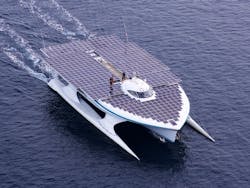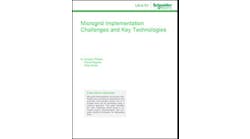Electric boats may enable floating microgrids that could serve islands that have historically been powered by fossil fuels, according to a report from researchers at the University of New South Wales in Sydney, Australia.
“Powering small islands with reliable, affordable and green electricity is a big challenge due to their dispersed geographical location with a limited number of consumers and the heavy dependence on fossil fuels,” said the study, “Real-Time Load and Ancillary Support for a Remote Island Power System Using Electric Boats.”
Floating microgrids made up of electric boat motors, renewable energy and controls offer a substitute that will help power an island and provide electricity after disasters.
Floating microgrids: Quick way to restore power after hurricanes
“When some natural disaster occurs in dispersed islands, the electricity networks or generation systems are heavily damaged, and residents live without electricity for weeks. In this case, consumers having this technology can immediately get their power, and the ships sent by the government to distribute food can also supply electricity,” said Jayashri Ravishankar, an author of the report, which was published by IEEE.
While electric boats (EB) are similar to electric vehicles (EV), electric boats offer some significant advantages as a microgrid resource. An electric car fitted with roof-mounted solar panels can’t always use available sunlight due to shade from buildings, trees and parking lots. However, electric boats with PV solar don’t have this problem.
“So, while EBs are at work, they still can charge their batteries,” Ravishankar said. “Therefore, unlike EVs, an EB can provide power to the grid even immediately after coming from a trip.”
Using a towed generator or a free-wheeling drive propeller, electric boats could provide power to the grid when they return to port.
A power plant that chases the sun
Electric boats also offer a work around the intermittency of renewable energy. A solar-powered electric boat is portable enough to leave an area with bad weather and charge up somewhere on the ocean where conditions are more suitable, the study said.
In essense, electric boats with renewable energy and controls can act as small power plants, and may participate in the bidirectional energy transactions of a virtual power plant in coastal areas, he said. They can also bid energy in coastal areas.
The boat could employ a bidirectional energy transfer mechanism available in electric boats, which is called boat-to-grid or B2G. Bidirectional energy transfer means that users can charge the boats while they’re on the water, and energy can be taken from the boat batteries.
The authors propose a new real-time load support system (RTLS) using electric boats, community generators and battery energy storage systems.
The RTLS system would control the power flow to and from electric boats and batteries. The controller would be connected to the electric boats, the battery storage, whatever solar generator is being used and also the grid. Extra energy from the solar would be routed to the battery, and a series of converters would enable energy transfer to and from the electric boats. Based on the grid load, power generation, and conditions of the battery and electric boat, the controller would coordinate the battery charging and discharging.
The system “analyzes the management of the intermittent sources…in real time, under various weather, load and battery state-of-charge conditions. The RTLS system coordinates the customers’ load demand with the available EBs, photovoltaics (PVs) and battery storage to provide efficient load support and to regulate the bus voltage and frequency,” said the study.
For example, with bidirectional energy transfer, the boats could charge their batteries during off-peak times and give power back to the grid during peak times, reducing peak demand and power quality issues.
Systems such as this would be highly adaptable to each of the user’s needs, and could be controlled simply by changing the inputs on the controller. While the underpinnings of the system would still be highly technical, the end user interface could be simple enough for anyone to use, said the report.
UNSW Sydney Microgrid Lab, Courtesy UNSW
Boats better than batteries
On small islands, power quality, grid stability, reliability, and load shedding issues are challenging, according to the report. Traditional battery storage solutions, such as large on-island batteries, would create cost concerns. If islands were to depend only on traditional battery storage systems, they would have to install far more than the demand to insure power quality, which would increase costs.
Using electric boat batteries could be a solution to all of these challenges. It could increase the overall stability of the power source while being environmentally friendly and less costly.
The proposed system was validated both in a real network as well as in a laboratory setup, according to the report.
The report concluded that the system can “substantially reduce the grid load demand and maintain the power quality under various load/ source uncertainties and fault conditions.”
In other words, electric boats not only transport people and goods; they can become floating microgrids and virtual power plants.
Track news about microgrid innovation. Subscribe to the free Microgrid Knowledge newsletter.








